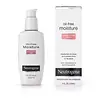What's inside
What's inside
 Key Ingredients
Key Ingredients

 Benefits
Benefits

 Concerns
Concerns

 Ingredients Side-by-side
Ingredients Side-by-side

Water
Skin ConditioningGlycerin
HumectantButyrospermum Parkii Butter
Skin ConditioningCetearyl Alcohol
EmollientMethylpropanediol
SolventGlyceryl Stearate
EmollientOctocrylene
UV AbsorberSodium Phenylbenzimidazole Sulfonate
UV AbsorberC12-15 Alkyl Benzoate
AntimicrobialCera Microcristallina
Emulsion StabilisingButyl Methoxydibenzoylmethane
UV AbsorberParaffinum Liquidum
EmollientCaprylic/Capric Triglyceride
MaskingGlyceryl Glucoside
HumectantPrunus Amygdalus Dulcis Oil
Skin ConditioningTocopheryl Acetate
AntioxidantPanthenol
Skin ConditioningDimethicone
EmollientPotassium Cetyl Phosphate
EmulsifyingHydrogenated Palm Glycerides
EmollientAcrylates/C10-30 Alkyl Acrylate Crosspolymer
Emulsion StabilisingChondrus Crispus Extract
Skin ConditioningEthylhexylglycerin
Skin ConditioningPhenoxyethanol
PreservativeMethylparaben
PreservativeEthylparaben
PreservativeTrisodium EDTA
Butylphenyl Methylpropional
PerfumingLinalool
PerfumingCitronellol
PerfumingBenzyl Alcohol
PerfumingLimonene
PerfumingGeraniol
PerfumingAlpha-Isomethyl Ionone
PerfumingCitral
PerfumingParfum
MaskingWater, Glycerin, Butyrospermum Parkii Butter, Cetearyl Alcohol, Methylpropanediol, Glyceryl Stearate, Octocrylene, Sodium Phenylbenzimidazole Sulfonate, C12-15 Alkyl Benzoate, Cera Microcristallina, Butyl Methoxydibenzoylmethane, Paraffinum Liquidum, Caprylic/Capric Triglyceride, Glyceryl Glucoside, Prunus Amygdalus Dulcis Oil, Tocopheryl Acetate, Panthenol, Dimethicone, Potassium Cetyl Phosphate, Hydrogenated Palm Glycerides, Acrylates/C10-30 Alkyl Acrylate Crosspolymer, Chondrus Crispus Extract, Ethylhexylglycerin, Phenoxyethanol, Methylparaben, Ethylparaben, Trisodium EDTA, Butylphenyl Methylpropional, Linalool, Citronellol, Benzyl Alcohol, Limonene, Geraniol, Alpha-Isomethyl Ionone, Citral, Parfum
Water
Skin ConditioningCyclomethicone
EmollientCetyl Ethylhexanoate
EmollientGlycerin
HumectantCetyl Ricinoleate
EmollientStearyl Alcohol
EmollientGlyceryl Stearate
EmollientPEG-100 Stearate
Methyl Methacrylate
Glycol Dimethacrylate Crosspolymer
Lysine Carboxymethyl Cysteinate
Skin ConditioningLysine Thiazolidine Carboxylate
Skin ConditioningTocopherol
AntioxidantSilica
AbrasiveXanthan Gum
EmulsifyingMethylparaben
PreservativePropylparaben
PreservativeDiazolidinyl Urea
PreservativeBenzalkonium Chloride
AntimicrobialWater, Cyclomethicone, Cetyl Ethylhexanoate, Glycerin, Cetyl Ricinoleate, Stearyl Alcohol, Glyceryl Stearate, PEG-100 Stearate, Methyl Methacrylate, Glycol Dimethacrylate Crosspolymer, Lysine Carboxymethyl Cysteinate, Lysine Thiazolidine Carboxylate, Tocopherol, Silica, Xanthan Gum, Methylparaben, Propylparaben, Diazolidinyl Urea, Benzalkonium Chloride
Ingredients Explained
These ingredients are found in both products.
Ingredients higher up in an ingredient list are typically present in a larger amount.
Glycerin is already naturally found in your skin. It helps moisturize and protect your skin.
A study from 2016 found glycerin to be more effective as a humectant than AHAs and hyaluronic acid.
As a humectant, it helps the skin stay hydrated by pulling moisture to your skin. The low molecular weight of glycerin allows it to pull moisture into the deeper layers of your skin.
Hydrated skin improves your skin barrier; Your skin barrier helps protect against irritants and bacteria.
Glycerin has also been found to have antimicrobial and antiviral properties. Due to these properties, glycerin is often used in wound and burn treatments.
In cosmetics, glycerin is usually derived from plants such as soybean or palm. However, it can also be sourced from animals, such as tallow or animal fat.
This ingredient is organic, colorless, odorless, and non-toxic.
Glycerin is the name for this ingredient in American English. British English uses Glycerol/Glycerine.
Learn more about GlycerinGlyceryl Stearate is a mix of glycerin and stearic acid.
It is used to stabilize the mixing of water and oil ingredients. By preventing these ingredients from separating, it can help elongate shelf life. It can also help thicken the product's texture.
As an emollient, it helps soften skin and supports barrier-replenishing ingredients.
In cosmetics, Glyceryl Stearate is often made from vegetable oils or synthetically produced.
This ingredient may not be fungal-acne safe
Fun fact: The human body also creates Glyceryl Stearate naturally.
Learn more about Glyceryl StearateMethylparaben is a preservative and is a paraben. It is used to prevent the growth of fungus, mold, and other harmful bacteria. Parabens are chemicals used as preservatives in both cosmetics and food.
Methylparaben can be synthetically created. It can also be found naturally in some fruits, such as blueberries.
Oftentimes, Methylparaben is combined with other parabens to help increase the shelf life.
The safety of Methylparaben is currently being studied. While ongoing studies are looking into the safety of parabens, the results have been very mixed. Some studies have not found Methylparaben to be harmful.
Learn more about MethylparabenWater. It's the most common cosmetic ingredient of all. You'll usually see it at the top of ingredient lists, meaning that it makes up the largest part of the product.
So why is it so popular? Water most often acts as a solvent - this means that it helps dissolve other ingredients into the formulation.
You'll also recognize water as that liquid we all need to stay alive. If you see this, drink a glass of water. Stay hydrated!
Learn more about Water